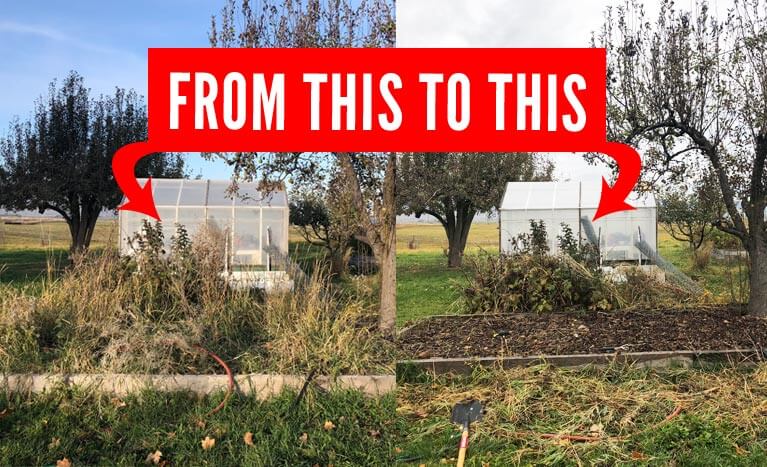I recently traded my comfortable home in the city for an old farmhouse with acreage—a farm that now consumes ALL my spare time. You can read about this life-changing event and watch my introduction to farm life.
This old farmhouse needs some serious TLC—in almost every direction, but I decided to address the bug invasion first. They were running everywhere and the previous owner seemed not at all concerned about them. She said: "Oh, those are just farm bugs; they don't hurt anything."
I was about to scream inside when I saw them (meaning LOTS of them) scurrying about like they owned the place, all over the porch, on the furniture, across the floor here and there, one or two on the window sill.
"This time of year, they all want to get in because it's getting colder out there..." she went on.
In my previous house, I had exactly zero bugs (that I knew about). Whenever I found one, I'd summarily dispatch it with a trusty Kleenex. Now I can either accept these roommates or I can take decisive action. I'll need something bigger, like a vacuum cleaner—maybe even a shop vac. I don't own a shop vac, never even seen one. I think you rent them at tool stores and they suck up gallons of sludge from plumbing accidents in basements, making loud noises that wake the neighborhood. I certainly need something more powerful than my little house vac.
I was like: "All these bugs are trying to get in my new home?! I'm used to dealing with one at a time! What do I do?!"
Thankfully, my dad taught me some useful techniques to slow the hordes and stem the bug tide. I built some landscaping barriers and caulked the perimeter to hold things over until spring: check out my post Stop Bugs By Sealing Cracks. Next year I'll need to resume that battle, but for now I can focus on other pressing farm projects.
Summer quickly became autumn, and with fall now slipping into winter, the cold weather hasn’t stopped me from my next big challenge: prepping the garden for spring.
I have a passion for gardening. Something deep within me aches to grow an abundant garden that provides for me and my family. I believe it's partly due to the connection I feel for my homesteading forebears. They lived in cold, harsh climates but were entirely self-sufficient with the produce they grew and the livestock they raised. Some of it is chronicled in a dusty box of black and white photos from my grandma's garage attic.
I aim to attain their level of sustainability! This little farm came with a small greenhouse, four raised garden beds, a variety of fruit trees, several berry bush patches, and fertile soil packed with nutrients! A LOT of work needs to be done to prep for spring! My first major task: clean the largest garden bed.
How do I clean up a garden bed?
Simple: put on gloves; get a shovel, and start digging and pulling weeds! Cleaning the surface will reveal the quality of the soil. Are there worms? Is it rocky, sandy, or clay-like? I should also test the soil to determine what compounds reside there, but I see an abundance of worms, which makes my gardening heart happy!
How do I prepare a garden bed for spring?
After removing the weeds, cover the bed with a few inches of leaves, straw, or wood chips! This gives the soil a protective cover. The leaves decompose to add nutrients while keeping the soil safe from wind. Another method is to “sheet compost” the soil by adding manure, then covering it up with one of the toppers. I will add manure into my soil from a field with cows, producing free fertilizer. Why not?!
What tools do I use to weed a garden?
A shovel, a hand weeder, and my hands. The hand weeder reaches the deep roots that are difficult or impossible to get by hand. Using gardening gloves, I can pull the majority of weeds and grass from the garden. I use the shovel for tough or hardy weeds. I'll research and invest in more quality garden tools to make this job easier in the future.
Why use manure in the garden?
Manure helps improve the texture and aeration of the soil. It adds nutrients because it's rich in nitrogen, organic matter, and a variety of minerals. Instead of purchasing soil add-ins from a garden store, I can use manure from the cows to save time and money. Add it to the garden beds now so it has time to compost into the soil over the winter. I'll use a garden fork to aerate the soil after adding the manure.
After three long days of cleaning out my garden bed, it was ready for manure conditioning! Instead of driving to the garden store (not this time), I took my shovel and bucket over to the field where the cows are. I have to say it was a bit disconcerting when I closed the gate behind me and started to scoop up manure. The entire herd came trotting over to greet me! I felt uneasy at first, wondering if they might be mad that I was invading their space. But I quickly realized they are just as friendly as I am, maybe even lonely for company. They surrounded me, so I didn’t have much space to work; I filled the small bucket and left.
This upcoming week, I'll be heading back out to the cow field to gather manure as I'm running out of time, racing to get my garden beds ready before the snow blows in and everything freezes up for the season.

